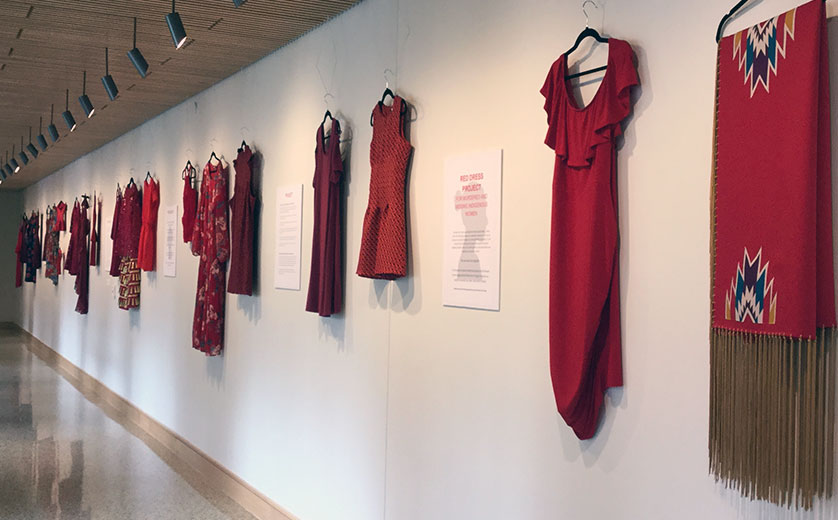During Native American Heritage Month, visitors to Hillman Hall can interact with the Red Dress Project commemorative installation. The piece displays 21 red garments— from dresses and infant onesies to jumpsuits and a shawl— suspended from the ceiling on black hangers.
The contrast of the red dresses hanging against the white walls is visually striking. However, the color was chosen because some indigenous cultures believe red is the only color that spirits can see. The REDress Project, created by Canadian artist Jaime Black in 2014, inspired the installation. Wall panels detail the ways in which non-Indigenous cultures are responsible for the epidemic of violence against Indigenous women in North America, as well as highlighting native history, instances of Missing and Murdered Indigenous Women (MWIW) in Missouri, and policy recommendations to combat the issue.
The idea for the exhibit came from Sierra Ayres, second-year Buder scholar and member of the Keweenaw Bay Indian Community Lake Superior Band of Ojibwe. Along with fellow planning committee members Melody Delmar, Charity Holmes, Patricia Pena and Clara Stenstrom, she solicited donations from members of the American Indian Student Association (AISA) for the installation. “We wanted to put this display together to bring awareness to this largely ignored issue and provide education around the reality of the violence perpetrated against Native women,” explains Ayres. “The red dress display is loud and powerful in the way that it forces you to actually see the empty dresses and think about the women who these represent.”
In the U.S., federal figures show that more than half of indigenous women encounter sexual or domestic violence at some point during their lives. A higher percentage of Native American and Alaska Native women go missing than any other group.
This year, the Buder Center students will focus their attention on the treatment of Indigenous women. Although many Indigenous cultures honor women, two-spirit, and gender variant people as essential community members and elevate their leadership, the sexism of non-Indigenous cultures often manifests as violence against Native women.
“Not only are a lot of our Native students focused on issues affecting women in Indian Country, like reproductive health, intimate partner violence, sex trafficking, and violence, but a lot of our students and our Tribal communities are directly affected by these issues of violence against our women,” said Ayres.
The Brown School invites students to visit the installation, and to enjoy other programming in honor of Native Heritage month.
